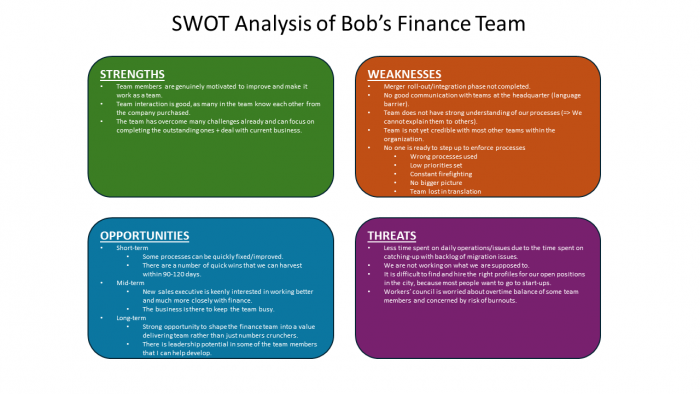
09 Mar TSLH #058: 3 Steps To Get You Into Action With a SWOT Matrix
Posted at 06:00h
in Newsletter
Read time: 4 minutes
When Bob (name changed) hired me as his executive coach a few years ago, his most immediate problem was to understand where to focus his energy as he was stepping into a new finance manager role.
To be frank, when Bob described his situation to me, it sounded much like his boss had thrown him in a river, looking at whether he would swim or sink. There were so many areas he had to look at, so many problems to tackle, he felt like his whole life may not suffice and he would never succeed.
This is a common feeling among leaders who take on a new team and a new responsibility: It seems like they need to drink from the hose, and they have a very limited time to make their mark. A standard question I get is where should I focus first?
It turns out there is a very nice tool, used widely in a lot of departments and business situations in all corporations. It’s called the SWOT matrix. SWOT stands for Strengths, Weaknesses, Opportunities, Threats. You may have seen these SWOT matrix already in Marketing, in strategic planning or any other place. The tool is very powerful to create clarity and this is the tool I proposed Bob to use in order to gain knowledge about what he should focus on.
Here’s the process I had Bob follow in order to create his SWOT matrix and what he did with it. Follow that same process and you can also create a lot of clarity for you. And by the way, the SWOT matrix can be used anytime, with any situation, it does not need to be limited to the time when you start in a new role.
My process can be fairly simply split into 3 distinct phases.
The investigation phase. This is the longest phase, as it will require you to learn a lot of things about the situation you want to analyze. The very first step is to define what you want a SWOT matrix for. In Bob’s case, he named it “SWOT Analysis of My German Finance Team”.
In this phase, you need to collect as much information as you can using a combination of the following methods:
- 1-on-1’s with your team members, your manager, stakeholders, possibly clients and vendors, essentially anyone who can provide you with relevant information for your SWOT matrix. In these discussions, you need to understand the different perspectives, split the truth from the fluff. For instance, Bob had conversations with his direct reports and some of their own direct reports, with the sales and consulting directors, with clients, with the GMs of the different business units.
- Analyze the situation from a process perspective: What is contributing to the perceived challenges, what has been tried before? What works vs. does not work?
- Look at how people communicate in the organization. In Bob’s case, he identified several key communication challenges between his team (Finance) and the sales team.
- Understand what people’s priorities are in the different teams (including yours) and what they most need from you to be effective.
- Look at the current business: What seems to work, what seems not to work? How does your team contribute to this (positively or negatively)?
- Understand your team’s culture, the organization culture and where there are disconnects.
My best recommendation here is to start this investigation phase as early as possible, even before your official day 1 in the office if you can afford that. Bob was named finance manager almost 3 months before taking over the role. However, he failed to leverage that time to start working on his SWOT matrix. By day 1, no wonder he felt completely overwhelmed.
The SWOT matrix build. Once your assessment has been done, it’s time to build your SWOT matrix.
After Bob’s investigation phase was over, he identified key elements that belonged to one of four buckets: Strengths his team had, weaknesses the team showed, opportunities within the organization and also outside for the team to step up and make its mark, and threats that could jeopardize Bob’s team and his own job.
This is what Bob’s SWOT matrix looked like:

The exercise you need to go through here is therefore this one: Just assemble all piece of information you have collected through your investigation phase and sort every piece into one of the four quadrant. If it does not belong to any of the quadrant, the info is probably not relevant and you can discard it.
Be wary of showing too many strengths and/or opportunities and very few weaknesses or threats. This can be a sign that your investigation phase is not over yet. In Bob’s case, given the number of challenges he had identified through discussions with his boss and stakeholders in the organization, he felt that he had captured the most relevant information for each quadrant.
The execution phase. Now that all information is available and has been sorted out using the four quadrants of the SWOT matrix, Bob needed to do something with it.
The best way to get into action using a SWOT matrix is to ask yourself 3 questions:
- How can I leverage the strengths to take advantage of the opportunities?
- What strategies should I design around the weaknesses to mitigate the impact of the threats?
- What is the sustainable value or competence the team has (or the situation offers) that can be enhanced to reinforce the impact?
When you answer these 3 questions, you pretty much have a plan ready to execute on and that will help you address the challenges you have and that had you start the SWOT matrix in the first place.
In Bob’s situation, this is what he came up with:
Leverage strengths to take advantage of the opportunities:
- Use the team motivation to do better to create a strong relationship with the sales executive and his team: Bob organized a one-day workshop to create stronger cohesion between the two teams.
- Prioritize the remaining outstanding items and focus on addressing all quick wins within the next 2 quarters: Bob had the team do a weekly meeting to prioritize tasks and focus on what needed to be completed by the end of each week.
- Foster the team interaction to create trust and identify the next leaders needed for the team: Bob identified 3 people in his team who people trusted and who were high performers. He promoted them to manager positions and they helped build the momentum for better performance.
Counter weaknesses to mitigate the impact of threats:
- Bob held 1-1 meetings with each of his direct reports and with the team as a group to set his expectations about roles and what the priorities were. In these meetings, he also explained key processes and got the team to commit to use them. This also helped strongly reduce the number of overtime hours.
- Bob protected the team from outside distraction and blaming by temporarily taking over some of the key relationships and communication with the headquarters. This gave the team enough space and time to work on the processes and all issues.
Identify sustainable value or competence:
- Bob identified that the team was producing a lot of good and reliable information that was not communicated to the right channels. By repurposing some reports and focusing a small team to produce regular reports for executive management, Bob turned his team from a pure cost center into a profit generator.
The SWOT matrix is one of the easiest tools to use in the context of stepping into a new leadership role and get clarity on what actions to take. It does take an initial significant effort to collect all the necessary information. However, once that information is there, building the SWOT matrix and executing on it are 2 steps that can be easily implemented. The level of clarity you get by using such a tool may surprise you. However, you will reap huge benefits quickly. Try it and let me know how it worked for you!
I wish you a great read. I’ll see you next Saturday!
TL; DR (Too Long, Did not Read)
3 steps to get you into action with a SWOT matrix
- The investigaton phase.
- The SWOT matrix build.
- The execution phase.
Whenever you’re ready, there are 3 ways I can help you:
1️⃣ Work 1-1 with me to step up as the authentic leader you aspire to be.
2️⃣ Hire me to help you build a high-performing team.
3️⃣ Start with my affordable digital courses on Mastering Difficult Conversations for Leaders and Goal Setting


